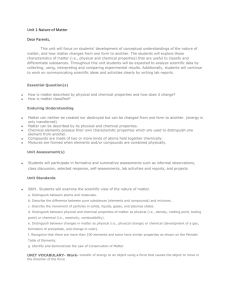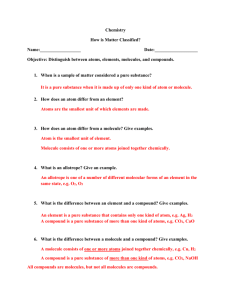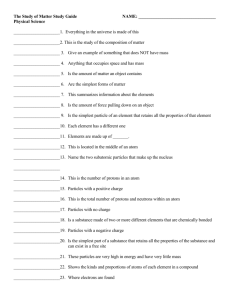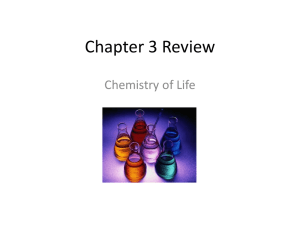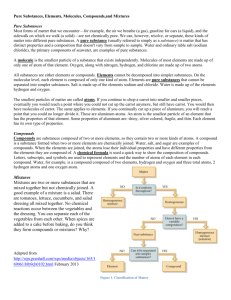Classification of Matter (PP)
advertisement
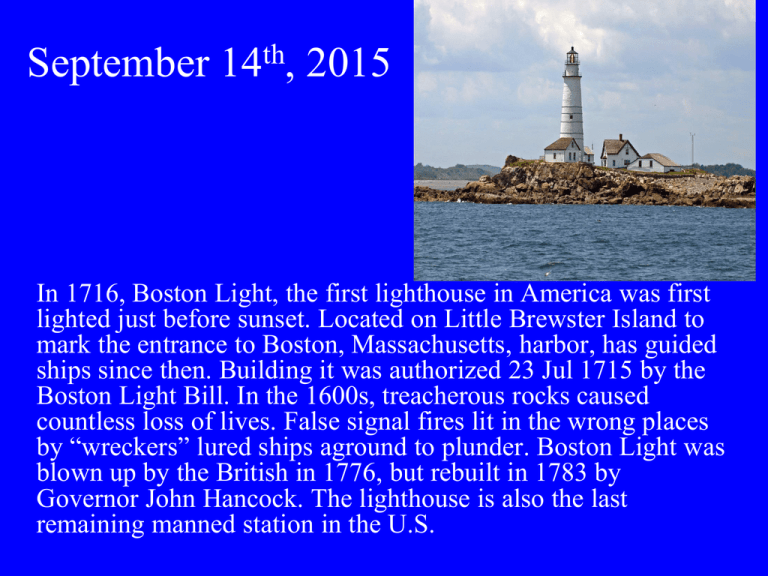
September 14th, 2015 In 1716, Boston Light, the first lighthouse in America was first lighted just before sunset. Located on Little Brewster Island to mark the entrance to Boston, Massachusetts, harbor, has guided ships since then. Building it was authorized 23 Jul 1715 by the Boston Light Bill. In the 1600s, treacherous rocks caused countless loss of lives. False signal fires lit in the wrong places by “wreckers” lured ships aground to plunder. Boston Light was blown up by the British in 1776, but rebuilt in 1783 by Governor John Hancock. The lighthouse is also the last remaining manned station in the U.S. Objectives • Complete lab safety quiz • Complete lab equipment quiz • Discuss Classification of Matter September 14th, 2015 Assessment Expectations! • Remain quiet during and after your assessment. • Remain seated. Turn your assessment over when finished. I will pick them up at the end of class. • Remain busy. Find something else to work on. Lab Equipment Quiz • I will dismiss a column at a time. If you are finished with the other parts of the quiz please wait patiently until it is your turn to take the quiz. Anything that has mass and takes up space. Mass is the quantity of matter. Volume is the amount of space the matter occupies. All atoms are matter and all matter is made up of atoms. Building blocks of the universe. Trillions upon trillions upon trillions upon trillions…of atoms, but currently only about 115 different types of atoms. Formed when two or more atoms chemically combine. Oxygen gas (O2), hydrogen gas (H2), water (H2O), and carbon dioxide (CO2) Substances made of the same element, yet have different physical and chemical structures. Oxygen can exist as oxygen gas (O2) and ozone (O3). Carbon exists in many different forms such as graphite, diamonds, and fullerene (aka Carbon 60 or Buckyballs). Formed when two or more ELEMENTS chemically combine. Water (H2O), carbon dioxide (CO2) Think of a compound sentence – you need two complete simple sentences to make it work and the sentences have to be different. In your notebook: Create a Venn diagram showing the relationship between molecules and compounds. Has an unchanging set of properties. Constant, defined composition – anything that is the exact or same throughout. Cannot be separated into simpler substances by physical means. Elements and compounds are pure substances. September 15th, 2015 In 1917, the term "bacteriophage" ("eater of bacteria") was coined in a note from Dr. Félix d'Hérelle to the French Academy of Sciences. Objectives • Finish Classification of Matter (PP) • Complete classification of matter (WS) Compounds are chemically combined in a way that neither of their individual properties are retained Elements are a specific type of atom and that atom cannot be broken down further and still be that specific element. Made of one type of atom Found on the Periodic Table Currently 118 known elements Made of MORE THAN 1 type of atom Can be decomposed or broken down into elements only by chemical means Two or more substances (elements or compounds) are added together, but not chemically combined. Water – oxygen and hydrogen are chemically combined, which means that neither of them display their individual properties anymore, they are a new substance. Salt water is a mixture made up of water (pure substance) and sodium chloride (pure substance). But the water is wet and if you drink it, it tastes like salt. Salt water does not take on new properties. Mixtures can be mixed in different proportions, but pure substances cannot. For example, water always combines in the ratio of 2 hydrogens and 1 oxygen. It is called the Law of Definite Proportions. Mixtures, however, can be made of 95% water and 5% salt, or 60% water and 40% salt, etc. The same composition of elements or compounds throughout; the particles are evenly distributed throughout. Examples: Salt water Kool-Aid (sugar water) Alloys (mixing two or more metals together) Not the same throughout; has different regions or areas with different compositions and properties. SOLUTE – Dissolved material SOLVENT – Dissolving material Assignment • Work with your 4 o’clock partner and complete “substance or mixture” worksheet • Suggested reading: section 3.1 pages 48-55 in textbook. • Read “The Disappearing Spoon”

